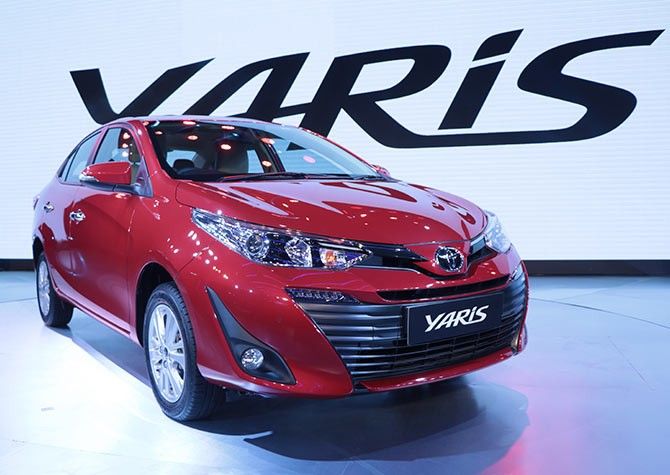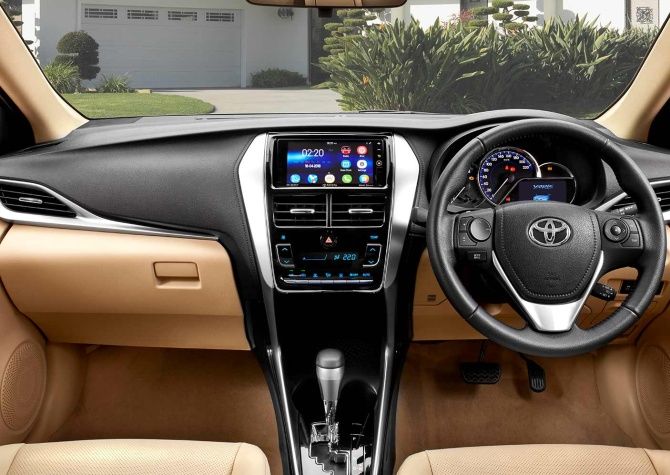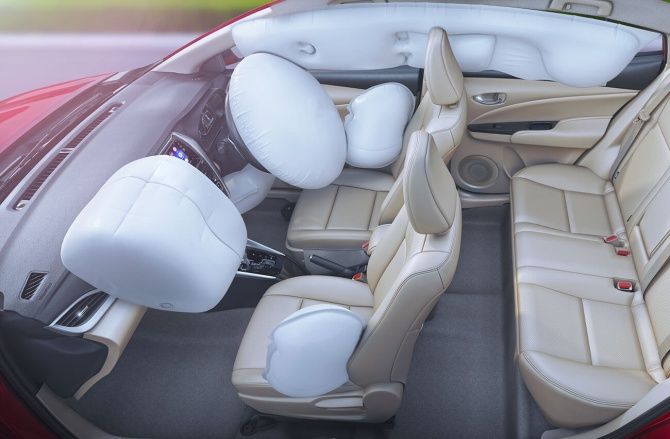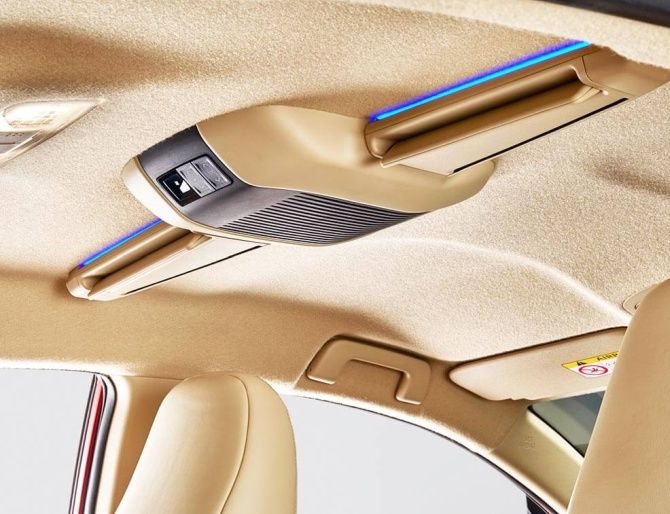 | « Back to article | Print this article |
The Toyota Yaris was finally launched in India last month. Rajesh Alva/Rediff.com offers a quick checklist of what appeals to him about the car, and what doesn't.
After a long wait, Japanese auto giant Toyota finally launched Yaris in India. It took Toyota almost three years of planning and strategising before launching the mid-size sedan in India. The car will be produced at Toyota's Bidadi plant near Bengaluru.

Photographs: Hitesh Harisinghani/Rediff.com
The Yaris will be competing with Hyundai Verna, segment leader Honda City and current favourite Maruti Ciaz. In anticipation of the challenges ahead, perhaps, Yaris is packed with features of which some are a first in the segment.
As India is seeing a dip in the sale of diesel cars, Toyota has launched only the petrol variant in India whereas globally it is available in both petrol and diesel variants.
Yaris is based on Toyota's global 'B' platform, but is different from the car sold in other markets.
It is well built and attractive. Toyota has smartly slotted Yaris in between the Etios and Corolla Altis.
Yaris seams like a stripped-down version of Toyota Corolla which is indeed a strong point as Corolla is hot seller globally.
The large smiley grille at front, massive air vents in the bumper, large wrap-around auto headlight unit with LED DRLs hiding under the headlamps and two muscular thick arches on the bonnet give it a premium look. However, Toyota could have added more chrome at the front to hide the plastic components.

Photographs: Hitesh Harisinghani/Rediff.com
The tail section is perhaps the best looking part about Yaris. The sleek wrap-around tail lamps and with LED inserts in it give it an exceptional look.
Yaris also features acoustic glass windows and sound deadening material which help in eliminating road noise.
The Yaris rests on 15 inch six-spoke alloy wheels which are one size smaller than what its rivals sport. But all four wheels get disc brakes with ABS (anti-lock braking system) and EBD (electronic brake force distribution), which offers a good braking power. Yaris also gets ESP (electronic stability program), there's traction control while the top version even get a tyre pressure warning system.
Power is produced by a 1.5-litre, four-cylinder inline, 16 Valve dual VVT-i (variable Valve timing with intelligence) petrol engine which generates 107bhp of power @ 6000rpm and 140Nm of torque @4200rpm. Power is transferred through 6-speed manual or 7-speed CVT (continuously variable transmission) gear box.
That may sound impressive but the Yaris lacks in power compared to its competitors. The Honda City's 1.5 lite engine produces 119PS of power and Hyundai Verna's 1.6 litre petrol engine generates 123PS of power, and they also have the option of a diesel engine.

Photographs: Kind courtesy Toyota Kirloskar Motor
Step into the cabin and you realise it is typical Toyota and resembles its elder brother, the Corolla Altis. The black and beige scheme and the centre console on the dashboard work well. Toyota refers to it as the 'waterfall design'.
The dashboard consists of a seven-inch touchscreen infotainment system with gesture control. Yes, you can wave your fingers in front of the unit to change the sound track or to lower or increase the volume without touching the unit. Initially it's a bit difficult to get used to this function. The 7 inch touchscreen looks like a last minute addition as it does not blend with the dashboard design. It also doesn't support Apple Car Play or Android Auto and there is no USB slot on the dashboard except the only one in the audio system.
Finishing levels are not up to the mark as there are plenty of hard plastic elements on the dashboard.
Climate control buttons are well backlit and offer good readability.

Photographs: Kind courtesy Toyota Kirloskar Motor
Yaris is also equipped with a power driver seat. You can easily adjust the driver's seat by pressing the buttons on it -- a boon for short drivers and it feels like a class above the segment.
Compared to its rivals the Yaris looks smaller in dimension.

Photographs: Kind courtesy Toyota Kirloskar Motor
The instrument cluster is part analogue and part digital. The digital console shows real time mileage and it also features a tyre pressure monitoring system which alerts you when the tyre pressure goes below the optimal level. There is also a gear-shift indicator. The instrument console is also easy to read in broad daylight.
Yaris is available in 4 variants -- J, G, V, VX -- and all variants get an automatic version.

Photographs: Kind courtesy Toyota Kirloskar Motor
Yaris comes with a lot of storage space in the cabin. There is a two-cup holder at front and large bottle holders on all four doors, two cup holders on the rear seat armrest and more storage space in the front arm rest box. Plus one large cooled glove box which will take care of your beverages.
The front seats are wide and very comfortable for long journeys but lack cooled/ventilated seats which are present in the Hyundai Verna. The rear seats are comfortable and offer a good thigh and back support. The front armrest box protrudes too much into the backseat making it difficult for the middle passenger to be comfortable over long journeys.
So despite having three seat belts at the rear, it's more suitable for two people. Taller people could also face some issue with the limited headroom due to the sloping roofline at the rear.
There are two charging points at the rear. The addition of a USB slot would have been helpful.

Photographs: Kind courtesy Toyota Kirloskar Motor
The Yaris comes with 7 airbags -- a first-in-segment . These include driver passenger units, side curtain bags and knee airbags. Airbags are standard across all variants. Some of the other features are impact sensing door lock, hill start assist, electronic stability control, cruise control, front and rear parking sensors and reverse camera.
The boot space is quite ample at 476 litres and the loading lip isn't too high either, but it is the smallest when compared to the competitors.

Photographs: Kind courtesy Toyota Kirloskar Motor
Yaris gets a roof mounted air con system with ambient light for rear passengers. Toyota claims the rear roof mounted AC helps cool the cabin quicker than the rear floor mounted AC unit. But the presence of roof mounted AC means there is no option for a sunroof.
Ground clearance for Yaris is at 152 mm, which is a bit less for speed bumps and the huge potholes on Indian roads. On the other hand, the Maruti Ciaz boasts of 170mm and Hyundai Verna boasts 165mm of ground clearance.

Photographs: Kind courtesy Toyota Kirloskar Motor
The Yaris gets gear paddle shifter behind the steering wheel for the automatic variant. The floor shifter too gets a nice leather with chrome finish. But it lacks a dead pedal in the automatic version.
The ARAI mileage for the automatic version is 17.8km/l while for the manual version it is 17.1km/l. So with the fuel tank capacity of 42 litres, we can expect a tank range of more than 600km.
Toyota has priced the Yaris in the range of Rs 8.75 lakh to Rs 14.07 lakh and it has put more focus on safety and comfort than performance and riding pleasure.
So the Yaris is a smart buy if you are feature-focused, as it has set some benchmarks in terms of safety, comfort level and features which are a first in segment.
But it is not the car for enthusiasts but more for those who value safety and reliability above everything else. Which goes with Toyota's reputation for reliable and durable vehicles.
| TOYOTA YARIS | HYUNDAI VERNA | HONDA CITY | MARUTI CIAZ | |
|---|---|---|---|---|
| Price (Ex-showroom Delhi) | 8.75 Lakh - 14.07 Lakh | 7.80 Lakh - 12.55 Lakh | 8.71 Lakh - 13.74 Lakh | 7.83 Lakh - 11.51 Lakh |
| Engine | 1.5-litre | 1.6/ 1.4-litre | 1.5-litre | 1.4-litre |
| Power | 107PS | 123PS/ 100PS | 119PS | 92PS |
| Torque | 140Nm | 151Nm/ 132Nm | 145Nm | 130Nm |
| Length | 4425mm | 4440mm | 4440mm | 4490mm |
| Width | 1730mm | 1729mm | 1695mm | 1730mm |
| Height | 1495mm | 1475mm | 1495mm | 1485mm |
| Wheelbase | 2550mm | 2600mm | 2600mm | 2650mm |